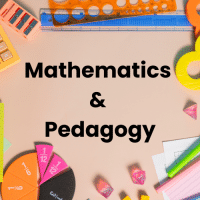CTET & State TET Exam > CTET & State TET Questions > Presenting disconnected chunks of knowledge w...
Start Learning for Free
Presenting disconnected chunks of knowledge would
- a)make it difficult for the learners to gain conceptual understanding
- b)make recall easier for the learners
- c)help learners organise information on their own
- d)make the task of the teacher difficult and that of the learners easy
Correct answer is option 'A'. Can you explain this answer?
| FREE This question is part of | Download PDF Attempt this Test |
Most Upvoted Answer
Presenting disconnected chunks of knowledge woulda)make it difficult f...
Presenting disconnected chunks of knowledge would make it difficult for the learners to gain conceptual understanding. This is because disconnected chunks of knowledge do not provide a clear and organized structure for learners to connect and integrate information. Here is a detailed explanation of why presenting disconnected chunks of knowledge would hinder conceptual understanding for learners:
1. Lack of coherence: Disconnected chunks of knowledge lack coherence, meaning that they do not have a logical flow or connection between different concepts or ideas. When learners are presented with information in a fragmented manner, it becomes challenging for them to see how different pieces of knowledge relate to one another. This lack of coherence makes it difficult for learners to build a comprehensive understanding of the subject matter.
2. Difficulty in building mental models: Conceptual understanding involves the construction of mental models or frameworks that help learners make sense of new information and connect it to their existing knowledge. Disconnected chunks of knowledge make it challenging for learners to construct these mental models. Without a clear structure or framework, learners may struggle to organize and integrate new information, impeding their ability to understand and apply concepts effectively.
3. Limited transferability: Disconnected knowledge is often limited in its transferability to real-life situations or other contexts. When learners are only exposed to isolated pieces of information, they may struggle to apply their knowledge to different scenarios. Conceptual understanding, on the other hand, allows learners to apply their knowledge flexibly and transfer it to new situations. Without a solid conceptual foundation, learners may find it challenging to apply what they have learned beyond the specific examples or contexts they have encountered.
4. Difficulty in problem-solving: Conceptual understanding is crucial for effective problem-solving. It enables learners to identify patterns, make connections, and apply relevant knowledge to solve complex problems. Disconnected chunks of knowledge hinder this process by preventing learners from seeing the bigger picture and understanding the underlying principles or concepts. As a result, learners may struggle to apply their knowledge strategically and efficiently when faced with problem-solving tasks.
In conclusion, presenting disconnected chunks of knowledge would make it difficult for learners to gain conceptual understanding. Without a coherent structure, learners may struggle to connect and integrate information, hindering their ability to build mental models, transfer knowledge, and solve problems effectively.
1. Lack of coherence: Disconnected chunks of knowledge lack coherence, meaning that they do not have a logical flow or connection between different concepts or ideas. When learners are presented with information in a fragmented manner, it becomes challenging for them to see how different pieces of knowledge relate to one another. This lack of coherence makes it difficult for learners to build a comprehensive understanding of the subject matter.
2. Difficulty in building mental models: Conceptual understanding involves the construction of mental models or frameworks that help learners make sense of new information and connect it to their existing knowledge. Disconnected chunks of knowledge make it challenging for learners to construct these mental models. Without a clear structure or framework, learners may struggle to organize and integrate new information, impeding their ability to understand and apply concepts effectively.
3. Limited transferability: Disconnected knowledge is often limited in its transferability to real-life situations or other contexts. When learners are only exposed to isolated pieces of information, they may struggle to apply their knowledge to different scenarios. Conceptual understanding, on the other hand, allows learners to apply their knowledge flexibly and transfer it to new situations. Without a solid conceptual foundation, learners may find it challenging to apply what they have learned beyond the specific examples or contexts they have encountered.
4. Difficulty in problem-solving: Conceptual understanding is crucial for effective problem-solving. It enables learners to identify patterns, make connections, and apply relevant knowledge to solve complex problems. Disconnected chunks of knowledge hinder this process by preventing learners from seeing the bigger picture and understanding the underlying principles or concepts. As a result, learners may struggle to apply their knowledge strategically and efficiently when faced with problem-solving tasks.
In conclusion, presenting disconnected chunks of knowledge would make it difficult for learners to gain conceptual understanding. Without a coherent structure, learners may struggle to connect and integrate information, hindering their ability to build mental models, transfer knowledge, and solve problems effectively.
Free Test
FREE
| Start Free Test |
Community Answer
Presenting disconnected chunks of knowledge woulda)make it difficult f...
The brain learns best and most efficiently when making connections and associations between new information and knowledge already processed and understood. The teachers must help the students learn by providing opportunities to relate new ideas or techniques to knowledge they have already mastered.
Hence, presenting disconnected chunks of knowledge would make it difficult for the learners to gain conceptual understanding, as the students are not able to make connections to the new information.
Hence, presenting disconnected chunks of knowledge would make it difficult for the learners to gain conceptual understanding, as the students are not able to make connections to the new information.
Attention CTET & State TET Students!
To make sure you are not studying endlessly, EduRev has designed CTET & State TET study material, with Structured Courses, Videos, & Test Series. Plus get personalized analysis, doubt solving and improvement plans to achieve a great score in CTET & State TET.

|
Explore Courses for CTET & State TET exam
|

|
Similar CTET & State TET Doubts
Presenting disconnected chunks of knowledge woulda)make it difficult for the learners to gain conceptual understandingb)make recall easier for the learnersc)help learners organise information on their ownd)make the task of the teacher difficult and that of the learners easyCorrect answer is option 'A'. Can you explain this answer?
Question Description
Presenting disconnected chunks of knowledge woulda)make it difficult for the learners to gain conceptual understandingb)make recall easier for the learnersc)help learners organise information on their ownd)make the task of the teacher difficult and that of the learners easyCorrect answer is option 'A'. Can you explain this answer? for CTET & State TET 2024 is part of CTET & State TET preparation. The Question and answers have been prepared according to the CTET & State TET exam syllabus. Information about Presenting disconnected chunks of knowledge woulda)make it difficult for the learners to gain conceptual understandingb)make recall easier for the learnersc)help learners organise information on their ownd)make the task of the teacher difficult and that of the learners easyCorrect answer is option 'A'. Can you explain this answer? covers all topics & solutions for CTET & State TET 2024 Exam. Find important definitions, questions, meanings, examples, exercises and tests below for Presenting disconnected chunks of knowledge woulda)make it difficult for the learners to gain conceptual understandingb)make recall easier for the learnersc)help learners organise information on their ownd)make the task of the teacher difficult and that of the learners easyCorrect answer is option 'A'. Can you explain this answer?.
Presenting disconnected chunks of knowledge woulda)make it difficult for the learners to gain conceptual understandingb)make recall easier for the learnersc)help learners organise information on their ownd)make the task of the teacher difficult and that of the learners easyCorrect answer is option 'A'. Can you explain this answer? for CTET & State TET 2024 is part of CTET & State TET preparation. The Question and answers have been prepared according to the CTET & State TET exam syllabus. Information about Presenting disconnected chunks of knowledge woulda)make it difficult for the learners to gain conceptual understandingb)make recall easier for the learnersc)help learners organise information on their ownd)make the task of the teacher difficult and that of the learners easyCorrect answer is option 'A'. Can you explain this answer? covers all topics & solutions for CTET & State TET 2024 Exam. Find important definitions, questions, meanings, examples, exercises and tests below for Presenting disconnected chunks of knowledge woulda)make it difficult for the learners to gain conceptual understandingb)make recall easier for the learnersc)help learners organise information on their ownd)make the task of the teacher difficult and that of the learners easyCorrect answer is option 'A'. Can you explain this answer?.
Solutions for Presenting disconnected chunks of knowledge woulda)make it difficult for the learners to gain conceptual understandingb)make recall easier for the learnersc)help learners organise information on their ownd)make the task of the teacher difficult and that of the learners easyCorrect answer is option 'A'. Can you explain this answer? in English & in Hindi are available as part of our courses for CTET & State TET.
Download more important topics, notes, lectures and mock test series for CTET & State TET Exam by signing up for free.
Here you can find the meaning of Presenting disconnected chunks of knowledge woulda)make it difficult for the learners to gain conceptual understandingb)make recall easier for the learnersc)help learners organise information on their ownd)make the task of the teacher difficult and that of the learners easyCorrect answer is option 'A'. Can you explain this answer? defined & explained in the simplest way possible. Besides giving the explanation of
Presenting disconnected chunks of knowledge woulda)make it difficult for the learners to gain conceptual understandingb)make recall easier for the learnersc)help learners organise information on their ownd)make the task of the teacher difficult and that of the learners easyCorrect answer is option 'A'. Can you explain this answer?, a detailed solution for Presenting disconnected chunks of knowledge woulda)make it difficult for the learners to gain conceptual understandingb)make recall easier for the learnersc)help learners organise information on their ownd)make the task of the teacher difficult and that of the learners easyCorrect answer is option 'A'. Can you explain this answer? has been provided alongside types of Presenting disconnected chunks of knowledge woulda)make it difficult for the learners to gain conceptual understandingb)make recall easier for the learnersc)help learners organise information on their ownd)make the task of the teacher difficult and that of the learners easyCorrect answer is option 'A'. Can you explain this answer? theory, EduRev gives you an
ample number of questions to practice Presenting disconnected chunks of knowledge woulda)make it difficult for the learners to gain conceptual understandingb)make recall easier for the learnersc)help learners organise information on their ownd)make the task of the teacher difficult and that of the learners easyCorrect answer is option 'A'. Can you explain this answer? tests, examples and also practice CTET & State TET tests.

|
Explore Courses for CTET & State TET exam
|

|
Suggested Free Tests
Signup for Free!
Signup to see your scores go up within 7 days! Learn & Practice with 1000+ FREE Notes, Videos & Tests.
























